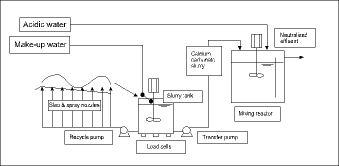
The treatment of acid water from mining processes is an ongoing challenge in the mining industry. The CSIR has patented technology for the neutralisation of acid leachates and acidic process water. The process involves collecting the acid effluent and treating it to acceptable standards, either for recycling as process water back to the plant, or to a standard suitable to return the water back to the environment. Thuthuka Project Managers is a licence holder of this CSIR patent.
The process hinges around the use of limestone precipitate as a neutralisation agent. In comparison to the use of lime, CaO or Ca(OH)2, the use of powder limestone allows for a substantial operating cost reduction. The process patented by the CSIR came about because precipitate is obtained inexpensively as a by-product of the papermaking process. During the water conditioning process, levels of pH, acidity and Iron(II) concentration are monitored at designated points in the process train.
Collieries on the Mpumalanga coalfields have a particular problem with acid water. Due to pyrites in the coal, acid water is produced when residual coal and coal waste from abandoned seams are exposed to air and water, according to the following reaction:
Neutralisation of this acid water is essential for maintaining water courses in good condition, should the treated effluent be discharged to the environment. To date, Thuthuka Project Managers has successfully completed its second commercial site implementing the CSIR's patented technology at one of the larger players in the coal mining industry, near Witbank, and at a heavy minerals recovery plant near Empangeni. A third plant is under construction in Botswana and a fourth is planned with a metals refinery on the East Rand.

System components
With reference to the diagram, the CaCO3 handling and dosing system comprises the following:
* A concrete slab for storage of CaCO3, sloped to allow CaCO3-slurry to gravitate into a slurry tank, adjacent to the slab.
* A CaCO3-slurry tank, with stirrer, which is positioned below ground level and mounted on loadcells to monitor the weight of the slurry tank continuously.
* A ball valve in the clear water make-up line to the slurry tank to maintain the water level in the tank at a specified level.
* A CaCO3-recycle slurry pump, which pumps slurried CaCO3 from the slurry tank through a set of nozzles into the CaCO3 dump. The slurried CaCO3 is returned by gravity via the sloped concrete slab back to the slurry tank. The CaCO3 concentration is controlled by a feedback control loop, comprising the load cells and set points in the PLC controller which activates/stops the recycle pump at pre-set low or high values.
* A transfer pump which doses slurried CaCO3 into the mixing reactor.
* A mixing reactor for the mixing of acid water and CaCO3, and the recovery of CO2 gas (if required by auxiliary processes).
Dr Jannie Maree, Divisional Fellow at the CSIR, comments: "The first constructed plants are in operation and show the following: firstly, that acid water with a pH of 2,9 and 130 mg/l iron(II) can be neutralised completely; secondly, that CaCO3 can be dosed at a constant concentration and thirdly, that the system requires little maintenance".
Francois le Roux, Project Manager at Thuthuka, adds: "The beauty of this technology lies in its simplicity. We manage to bring together a simple yet robust design, operating very effectively. And that is what the client is after. His concern should not be a chemical dosing system that fails every now and then. His focus should be on his production plant - almost allowing himself the luxury of forgetting about auxiliary systems supporting his production plant."
Bill Pullen, Managing Director of Thuthuka Project Managers, reports that the third system Thuthuka is implementing in Botswana is scheduled for completion in early 2002, and the fourth, on the East Rand, should be completed during the first half of 2002. He adds that the success of this robust technology holds great promise in the coal and metals processing industry.
Thuthuka Project Managers
(031) 205 8624

© Technews Publishing (Pty) Ltd | All Rights Reserved